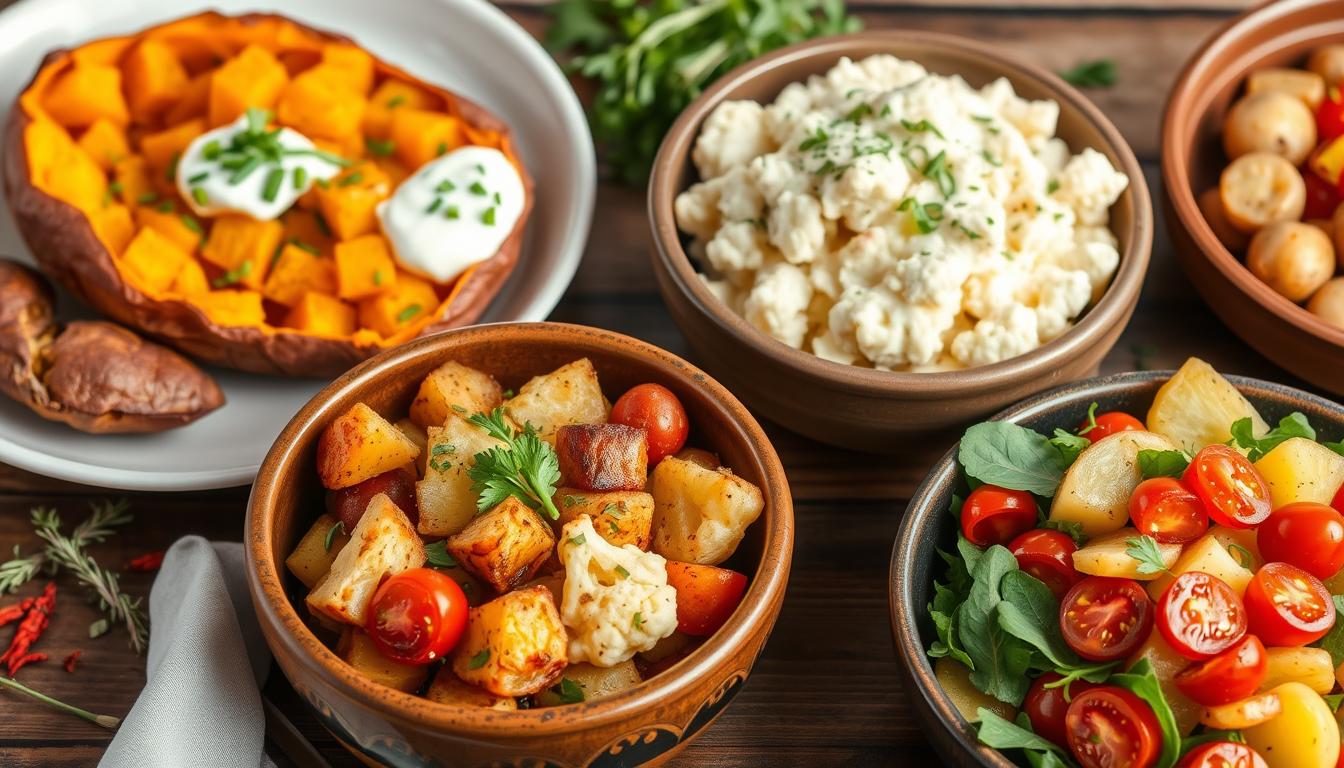
Potatoes can be a yummy and healthy part of your meals, even if you have diabetes. When you cook them the right way, you can enjoy them without worrying about your blood sugar.
This guide will help you pick the best potatoes and show you how much to eat. We’ll share easy ideas for making tasty potato dishes that are good for you. Whether you’re looking for new recipes or just want to know more, this guide will help!
Understanding Potatoes and Diabetes Management
When you have diabetes, it’s important to know how foods affect your blood sugar. Potatoes can be part of a healthy diet, but you need to pick the right ones.
Sweet potatoes and new potatoes are better for blood sugar because they don’t cause a big spike. White potatoes can raise blood sugar faster, but if you eat them in smaller amounts and cook them in a healthy way, they can still be okay for diabetics.
When you pick potatoes, keep these tips in mind:
- Fiber: Potatoes with more fiber are good for your body.
- Sugar: Choose potatoes with less sugar to keep your sugar levels balanced.
- Cooking: Boil, bake, or steam potatoes to keep them healthy.
Choosing the right potatoes and cooking them properly helps keep your body healthy
| Potato Type | Glycemic Index | Fiber Content |
|---|---|---|
| Sweet Potatoes | 50-60 | 3-4 grams per 100g |
| New Potatoes | 60-70 | 2-3 grams per 100g |
| White Potatoes | 80-90 | 1-2 grams per 100g |
Best Potato Varieties for Diabetics
For people with diabetes, it’s important to choose potatoes that are healthy. Sweet potatoes, Russet potatoes, and red potatoes are great choices. They are full of fiber and important nutrients that help keep blood sugar levels stable. You can bake or boil them for a tasty, healthy meal.
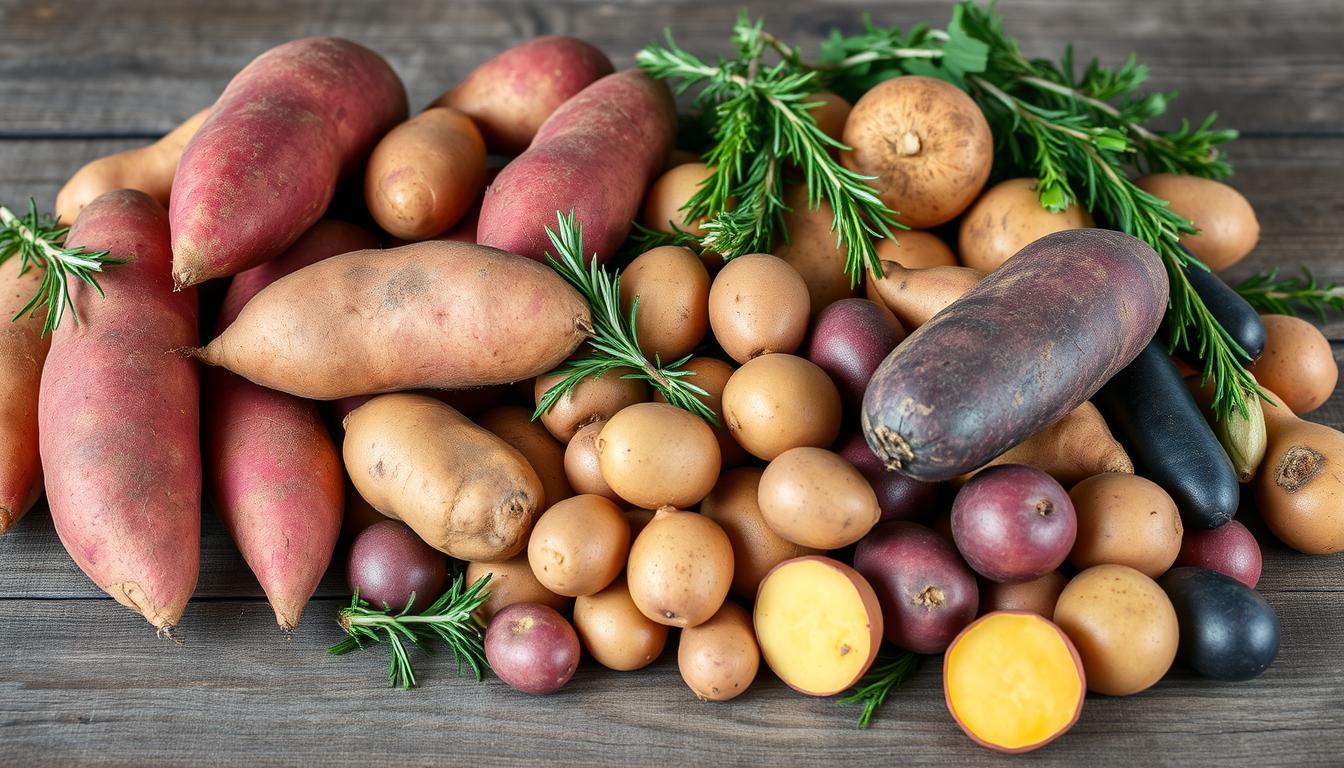
Essential Preparation Steps for Diabetes-Friendly Potato Dishes
Preparing potatoes for diabetic-friendly meals is key. It’s important to follow potato preparation techniques for healthy and tasty dishes. You need to know about portion control and cooking techniques to get the best flavors and nutrition.
First, wash and clean the potatoes well. This removes dirt, bacteria, and pesticides. Gently scrub them under cold water, then dry with a clean towel to avoid moisture.
Proper Washing and Cleaning Techniques
Once the potatoes are clean, slice them into serving portions. Cubes, slices, or wedges are all acceptable cuts. Diabetic meals benefit from their lower glycemic index and smaller pieces.
Cutting Methods to Control Portion Size
Pre-cooking tips are also crucial. Remove excess starch from diced potatoes by soaking them in cold water. This lowers the glycemic index even more. By following these steps and using the right cooking techniques, people with diabetes can enjoy healthy potato dishes while managing their blood sugar.
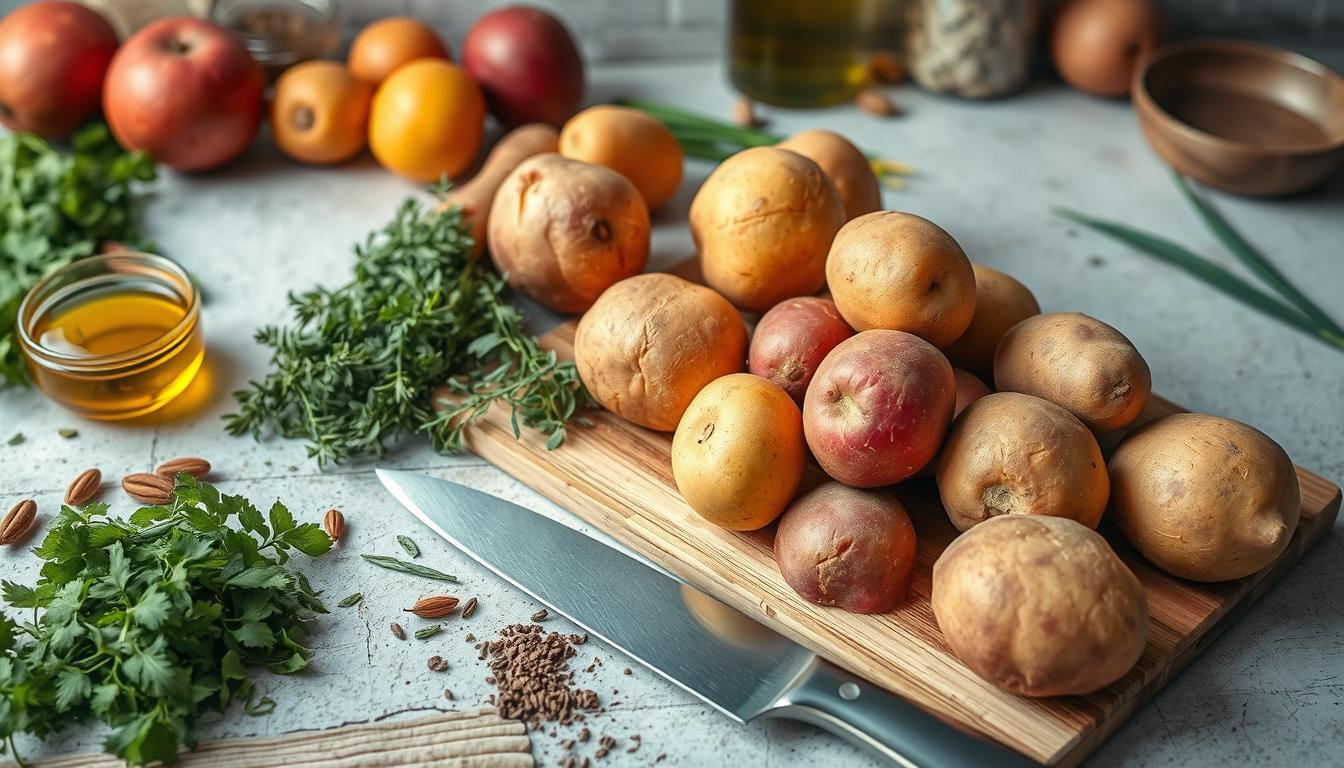
How to Cook Potatoes for Diabetics: Basic Methods
Cooking potatoes is a great way to make a tasty and healthy meal for diabetics. You can use cooking methods like boiling, baking, and steaming. Each method has its own benefits and can enhance the potatoes’ natural flavor.
It’s important to think about the cooking time and temperature when cooking potatoes. Boiling is good because it keeps nutrients in the potatoes. Baking is popular because it cooks evenly and brings out the potatoes’ sweetness. You can also steam the potatoes, which keeps the taste and nutrients inside.
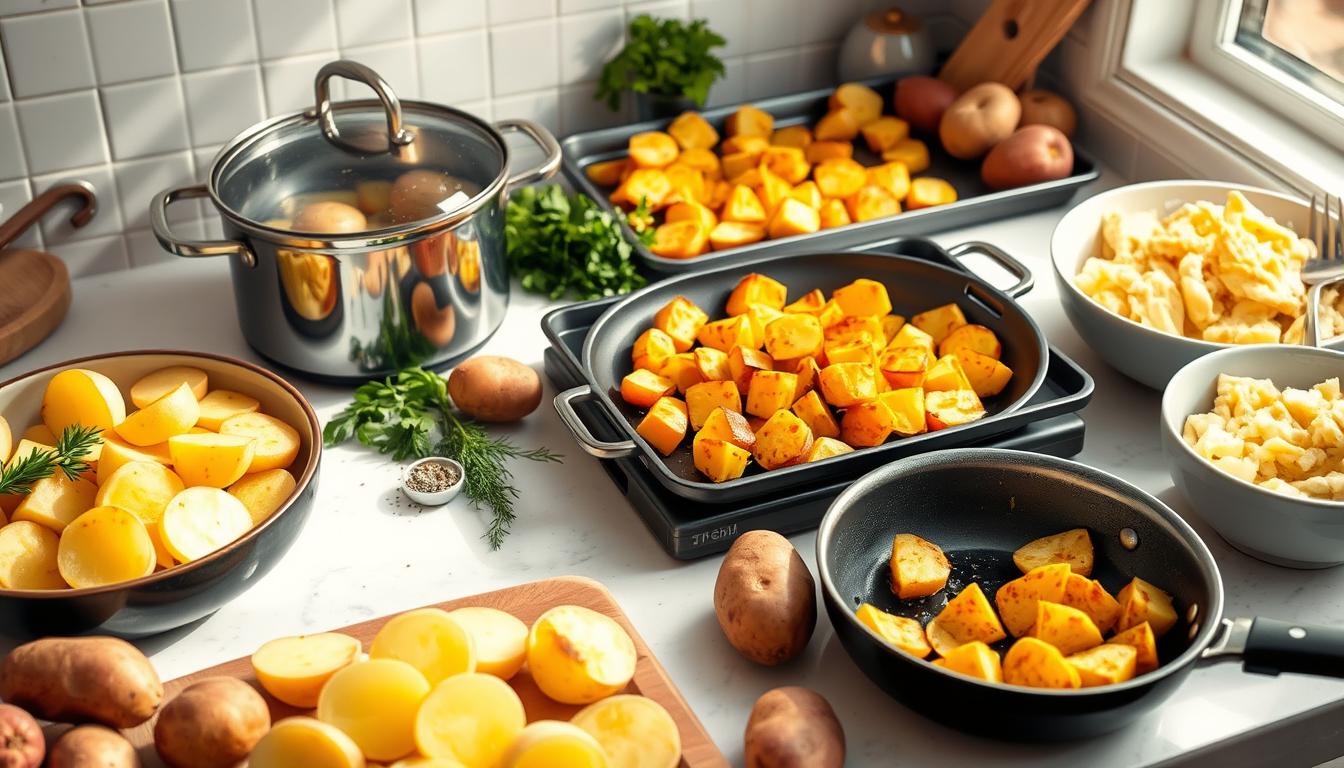
- Use high-quality potatoes that are rich in nutrients and fiber.
- Based on the type of potatoes and the taste you want, pick the right way to cook them.
- Monitor the cooking time and temperature to ensure that the potatoes are cooked to perfection.
By following these tips and using the right cooking methods, you can make delicious and healthy potato dishes for diabetics. Whether you like boiling, baking, or steaming, there’s a method for you.
Smart Portion Control Strategies
When it comes to healthy eating, portion control is key, even more so for those with diabetes. Diabetes management means watching how much food you eat. Potatoes can be part of a healthy diet if eaten in the right amounts. It’s important to measure and control how much you eat.
Using a food scale or measuring cups is a simple way to do this. For example, a serving of cooked potatoes is about 1/2 cup or 100g. Knowing serving sizes helps avoid overeating and keeps your diet balanced. Also, eating slowly and enjoying each bite can stop you from eating too much.
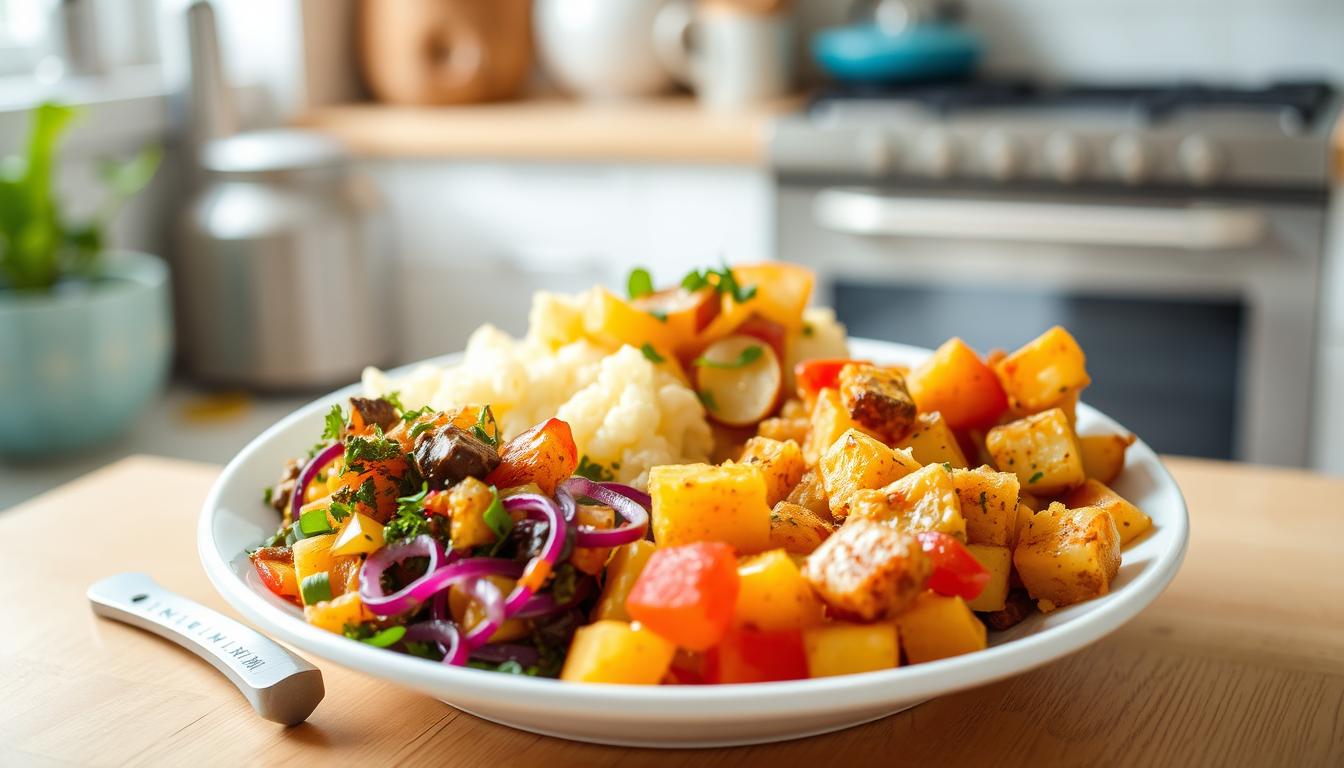
Another way to control portions is to use smaller plates and bowls. This trick makes you feel like you’re eating more, helping you stick to your diet. By using these strategies, people with diabetes can enjoy their favorite potato dishes while managing their diabetes well.
Here are some tips for healthy eating and portion control:
- Eat regular meals to avoid overeating
- Choose whole, unprocessed foods like potatoes, fruits, and vegetables
- Drink plenty of water to stay hydrated
Healthier Seasoning Alternatives
Many people use salt and sugar to flavor potato dishes. But, for those watching their diet, there are healthier seasonings that taste great without being bad for you. Herbs and spices can add flavor without extra salt or sugar.
Herbs and Spices for Flavor Enhancement
Herbs like rosemary, thyme, and garlic powder are great for potatoes. They can make your dish taste savory or slightly sweet. Also, low-sodium options like lemon juice or vinegar can add a tangy taste without salt.
Low-Sodium Seasoning Options
If you’re watching your sodium, there are many low-sodium options out there. Potassium chloride or salt-free seasoning blends are good alternatives. They let you flavor your potatoes without the sodium.
Natural Flavor Boosters
There are also natural flavor boosters for potatoes. Good accompaniments include roasted garlic, caramelized onions, and sautéed mushrooms. They add depth to your dish without salt or sugar.
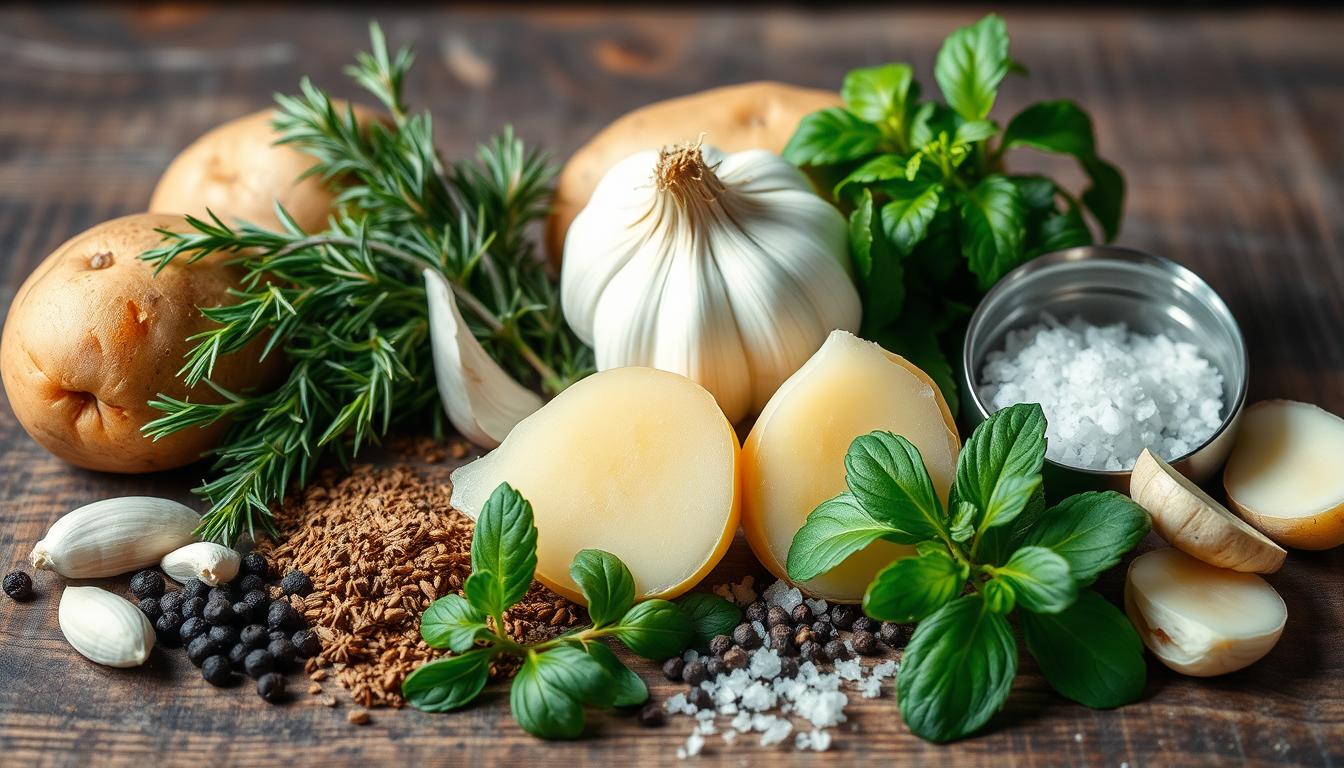
Using these healthier seasonings and natural flavor boosters can make your potato dishes tasty and healthy. Whether you need low-sodium options or just want to spice up your meals, there are plenty of choices.
Cooling and Reheating Methods
Keeping food safe is key, and cooling and reheating right is crucial. Cooling techniques stop bacteria growth. Cooked potatoes should go in a shallow container in the fridge at 40°F (4°C) or below within two hours.
To safely reheat potatoes, the internal temperature must hit 165°F (74°C). Safe ways to do this include:
- Reheating in the oven at 350°F (175°C)
- Reheating on the stovetop over low heat
- Reheating in the microwave, covering the potatoes with a microwave-safe lid or plastic wrap
By following these steps, people with diabetes can enjoy potatoes safely. It’s important to keep food safe to eat well.
Here’s a quick summary:
| Cooling Method | Reheating Method | Internal Temperature |
|---|---|---|
| Shallow container in the refrigerator | Oven at 350°F (175°C) | 165°F (74°C) |
| Ice bath | Stovetop over low heat | 165°F (74°C) |
| Refrigerator at 40°F (4°C) or below | Microwave with a microwave-safe lid or plastic wrap | 165°F (74°C) |
Combining Potatoes with Other Diabetes-Friendly Foods
Managing diabetes means eating balanced meals with various healthy foods. Potatoes are a good choice when paired with the right foods. Adding protein like grilled chicken or fish helps control blood sugar and keeps you full.
Here are some protein pairings with potatoes:
- Grilled chicken breast with roasted potatoes and steamed vegetables
- Lentil soup with a side of boiled potatoes
Vegetables can also add nutrients and flavor to potato dishes. Try pairing potatoes with roasted or sautéed veggies like Brussels sprouts, carrots, spinach, or bell peppers.
Adding potatoes to your meals can make them balanced and nutritious. Here are some meal ideas:
| Meal | Ingredients |
|---|---|
| Grilled chicken and roasted potatoes | Chicken breast, potatoes, olive oil, salt, and pepper |
| Baked salmon and sweet potato | Salmon fillet, sweet potato, lemon juice, and herbs |
Common Cooking Mistakes to Avoid
When cooking potato dishes for diabetics, it’s key to steer clear of common cooking mistakes. These can harm food safety and meal quality. Ensuring potatoes are cooked just right is crucial.
To sidestep these errors, here are some tips:
- Check the temperature with a food thermometer to make sure it’s safe to eat.
- Store cooked potatoes in a sealed container in the refrigerator to prevent bacterial growth.
By sticking to these tips and being careful, you can make tasty, healthy cooking options for diabetics. These meals should focus on food safety. Remember, the secret to great cooking is paying attention to every detail and using safe, healthy methods.
Meal Planning and Storage Tips
Managing diabetes through diet starts with meal planning. Planning meals ahead ensures you eat healthy, balanced meals. This helps keep blood sugar levels stable. For instance, store potatoes in a cool, dark spot to keep them fresh for up to two weeks.
It’s also key to follow reheating guidelines when planning meals. Reheating food is convenient but must be done safely to avoid illness. Here are some reheating tips:
- Make sure the food reaches an internal temperature of 165°F, or 74°C, before reheating.
- Check the temperature with a food thermometer to make sure it’s safe to eat.
- Reheat food only once, and make sure it’s steaming hot before serving
By using these meal planning and storage tips, you can enjoy healthy, balanced meals safely. And by following reheating guidelines, you can eat without worrying about getting sick. Here’s a table with some healthy meal ideas:
| Meal Idea | Ingredients | Reheating Instructions |
|---|---|---|
| Baked Potato with Vegetables | Potato, broccoli, carrots | Reheat in the oven at 350°F (180°C) for 10-15 minutes |
| Potato Soup | Potatoes, vegetables, chicken broth | Reheat on the stovetop or in the microwave until steaming hot |
Conclusion
As we wrap up this guide on cooking potatoes for diabetics, the main point is clear. With a few tweaks, you can still enjoy potatoes while keeping your diet healthy. Learning about the glycemic index of potatoes, how to cook them right, and finding tasty seasonings can help. This way, diabetics can enjoy potatoes without worrying about their blood sugar.
Managing diabetes is a long-term effort, and eating right is key. We suggest trying new recipes and cooking methods. Find what works best for you. With a bit of creativity and careful portion sizes, potatoes can be a part of your healthy meals.
We wish you all the best on your diabetes management journey. Keep learning, be patient, and ask for help when needed. Let’s work together towards a future where we can enjoy our favorite foods and stay healthy.
FAQ
What are the best potato varieties for diabetics?
For diabetics, sweet potatoes, Russet potatoes, and red potatoes are great. They have a lower glycemic index. This means they don’t raise blood sugar levels as much.
How can I control the portion size of potatoes?
Use smaller plates or measuring cups for portion control. Cutting potatoes into smaller pieces also helps.
What are some healthy seasoning alternatives for potato dishes?
Use herbs and spices like garlic, rosemary, thyme, and paprika. Avoid high-sodium seasonings. Instead, try low-sodium options or natural flavor boosters like lemon juice or vinegar.
How can I safely reheat cooked potatoes?
Store cooked potatoes in the fridge and reheat to 165°F (74°C). Don’t reheat potatoes too many times to avoid foodborne illness.
What are some diabetes-friendly ways to combine potatoes with other foods?
Pair potatoes with lean proteins like grilled chicken or fish. Add non-starchy veggies like broccoli, spinach, or bell peppers. This makes a balanced, diabetes-friendly meal.
What are some common cooking mistakes to avoid when preparing potatoes for diabetics?
Avoid overcooking potatoes, as it raises the glycemic index. Don’t use high-fat cooking methods like deep frying. Also, steer clear of adding high-sugar or high-sodium ingredients.
Leave a Reply